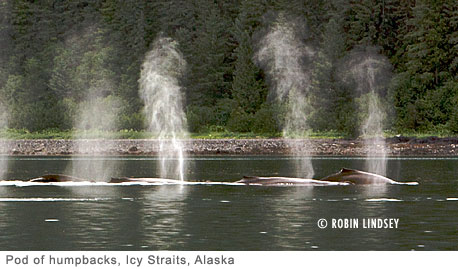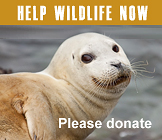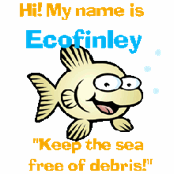Marine mammals great and small in our area waters
Feb/17/14 07:55 AM
A report of a humpback whale off Lowman Beach was fielded by Seal Sitters’ hotline yesterday afternoon. West Seattle photographer and writer Judy Lane was out observing eagles when she noticed a humpback whale off shore, slapping the surface of the water with his or her massive tail (behavior known as a tail lob). Worried that the whale might be entangled near a buoy, Judy notified Donna Sandstrom of The Whale Trail (see Judy’s photos on their Facebook page) who quickly gave our stranding network a heads up that we had a whale in the area. The whale was last sighted around 2pm swimming freely and headed south near Lincoln Parks’ Pt. Williams. With high winds and choppy seas, a whale at a distance can be quite difficult to see without the telltale blow.
 Humpbacks are currently on the ESA endangered species list. Reaching lengths of up to 60 feet, females are larger than males. Through their baleen, they filter krill, plankton and other small crustaceans - up to 3,000 lbs a day. Newborn calves are about 15 feet in length, weighing around 1 ton and spend up to 10 months with mom.
Humpbacks are currently on the ESA endangered species list. Reaching lengths of up to 60 feet, females are larger than males. Through their baleen, they filter krill, plankton and other small crustaceans - up to 3,000 lbs a day. Newborn calves are about 15 feet in length, weighing around 1 ton and spend up to 10 months with mom.
Cascadia Research, based in Olympia, estimates that approximately 1,600 humpbacks feed off the Pacific Coast of North America, with 500 along the waters of Washington and British Columbia. An increasing number of mothers with calves have been sighted in Puget Sound and straits of the Pacific Northwest. A January sighting of a humpback in Puget Sound is unusual and could be of concern since most of the whales should be in Hawaii or Mexico this time of year. A humpback was also reported in Hood Canal last year in late January.
The annual migration of the humpback whale is the longest of any mammal on earth. Found in oceans all over the world, one typical migration from Alaska to Hawaii is over 3,000 miles, often completed in a little over a month. Swimming at the surface along the way, whales face grave dangers from marine debris, such as nets and crab pots. Watch a NOAA video here showing a whale disentanglement team freeing an entangled humpback - and learn how your vigilance and detailed reporting can help save whales from injury and death.
If you see a whale in Seattle’s Elliott Bay or the waters of Puget Sound near West Seattle, please report the sighting to Seal Sitters MMSN hotline @ 206-905-7325 (SEAL). As the marine mammal stranding network for this area, we like to be aware of any whales close to our shores. Photos of flukes and dorsal fins or dorsal bumps (gray whales) are extremely helpful not only for species identification, but also to identify individuals in the cetacean database kept by local researchers at Cascadia (1-800-747-7329) and Orca Network. If you are in a boat, please remember that whales are protected by the Marine Mammal Protection Act and stay back.
On Saturday, in a downpour, Seal Sitters volunteers watched over a much smaller visitor - a seemingly healthy seal yearling (born during last year’s pupping season) - resting and draped over the edge of an Elliott Bay rock. As the tide crept in and washed over his dangling rear flippers, he slipped off his perch into the gray, rain-splattered waters. Drenched first responders returned home to dry out.
Over the past few weeks, seal pups have made brief appearances on shore. Weaned and wiser at 5-8 months old, they are much more wary of people and dogs. The offshore rafts along Alki and Beach Drive have seen a fair amount of activity with resting pups.

Cascadia Research, based in Olympia, estimates that approximately 1,600 humpbacks feed off the Pacific Coast of North America, with 500 along the waters of Washington and British Columbia. An increasing number of mothers with calves have been sighted in Puget Sound and straits of the Pacific Northwest. A January sighting of a humpback in Puget Sound is unusual and could be of concern since most of the whales should be in Hawaii or Mexico this time of year. A humpback was also reported in Hood Canal last year in late January.
The annual migration of the humpback whale is the longest of any mammal on earth. Found in oceans all over the world, one typical migration from Alaska to Hawaii is over 3,000 miles, often completed in a little over a month. Swimming at the surface along the way, whales face grave dangers from marine debris, such as nets and crab pots. Watch a NOAA video here showing a whale disentanglement team freeing an entangled humpback - and learn how your vigilance and detailed reporting can help save whales from injury and death.
If you see a whale in Seattle’s Elliott Bay or the waters of Puget Sound near West Seattle, please report the sighting to Seal Sitters MMSN hotline @ 206-905-7325 (SEAL). As the marine mammal stranding network for this area, we like to be aware of any whales close to our shores. Photos of flukes and dorsal fins or dorsal bumps (gray whales) are extremely helpful not only for species identification, but also to identify individuals in the cetacean database kept by local researchers at Cascadia (1-800-747-7329) and Orca Network. If you are in a boat, please remember that whales are protected by the Marine Mammal Protection Act and stay back.
On Saturday, in a downpour, Seal Sitters volunteers watched over a much smaller visitor - a seemingly healthy seal yearling (born during last year’s pupping season) - resting and draped over the edge of an Elliott Bay rock. As the tide crept in and washed over his dangling rear flippers, he slipped off his perch into the gray, rain-splattered waters. Drenched first responders returned home to dry out.
Over the past few weeks, seal pups have made brief appearances on shore. Weaned and wiser at 5-8 months old, they are much more wary of people and dogs. The offshore rafts along Alki and Beach Drive have seen a fair amount of activity with resting pups.







